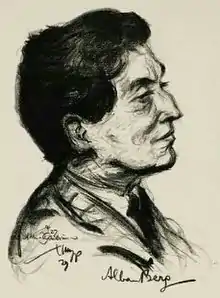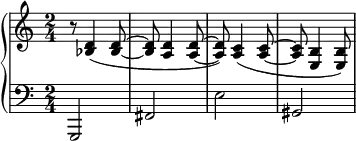Violin Concerto (Berg)
Alban Berg's Violin Concerto was written in 1935 (the score is dated 11 August 1935). It is probably Berg's best-known and most frequently performed piece. In it, Berg sought to reconcile diatonicism and dodecaphony. The work was commissioned by Louis Krasner, and dedicated by Berg to "the memory of an angel", Manon Gropius. It was the last work he completed. Krasner performed the solo part in the premiere at the Palau de la Música Catalana, Barcelona, on 19 April 1936, after the composer's death.
| Violin Concerto | |
|---|---|
| by Alban Berg | |
 Sketch of the composer by Emil Stumpp | |
| Genre | Concerto |
| Composed | 1935 |
| Dedication | "To the memory of an angel" (Manon Gropius) |
| Movements | Two (in two sections each) |
| Scoring | Violin and orchestra |
| Premiere | |
| Date | 19 April 1936 |
| Location | Palau de la Música Catalana, Barcelona |
| Conductor | Hermann Scherchen |
| Performers |
|
Conception and composition
The piece stemmed from a commission from the violinist Louis Krasner. When he received the commission, Berg was working on his opera Lulu, and did not begin work on the concerto for some months. The event that spurred him into writing was the death by polio of 18-year-old Manon Gropius, the daughter of Alma Mahler (once Gustav Mahler's wife) and Walter Gropius. Berg set Lulu aside to write the concerto, which he dedicated "To the memory of an angel".[2]
Berg worked on the piece very quickly, completing it in a few months; it is thought that his work on the concerto was largely responsible for his failing to complete Lulu before his death on 24 December 1935. The concerto was the last work he completed. In a letter to Krasner dated 16 July 1935, Berg confessed:
Yesterday I finished the composition [without the orchestration] of our Violin Concerto. I am probably more surprised by it than you will be ... the work gave me more and more joy. I hope – no, I have the confident belief – that I have succeeded.
Scoring
The concerto is scored for 2 flutes (both doubling as piccolo), 2 oboes (one doubling as a cor anglais), alto saxophone (doubling as 3rd clarinet), 2 clarinets, bass clarinet, 2 bassoons, contrabassoon, 4 horns, 2 trumpets, 2 trombones, tuba, timpani, percussion, harp and strings.[2]
Music
| External audio | |
|---|---|
| Performed by Isabelle Faust with the Orchestra Mozart under Claudio Abbado | |
Berg described the structure of the concerto in a letter to Arnold Schoenberg.[3] It is in two movements, each divided into two sections:
- Andante (Prelude)
- Allegretto (Scherzo)
- Allegro (Cadenza)
- Adagio (Chorale Variations)
The work begins with an Andante in classical sonata form, followed by the Allegretto, a dance-like section. The second movement starts with an Allegro largely based on a single recurring rhythmic cell; this section has been described as cadenza-like, with very difficult passages in the solo part. The orchestration becomes rather violent at its climax (marked in the score as "High point of the Allegro"); the fourth and final section, marked Adagio, is much calmer. The first two sections are meant to represent life, the last two death and transfiguration.

Like many of Berg's works, the piece combines the twelve-tone technique, typical of serialist music learned from his teacher Arnold Schoenberg, with passages written in a freer, more tonal style. The score integrates serialism and tonality in a remarkable fashion. Here is Berg's tone row:
Although this contains all twelve notes of the chromatic scale, there is a strong tonal undercurrent: the first three notes of the row make up a G minor triad; notes three to five are a D major triad; notes five to seven are an A minor triad; notes seven to nine are an E major triad;
and the last four notes (B, C♯, E♭, F) and the first (G) together make up part of a whole tone scale. The roots of the four triads correspond to the open strings of the violin, which is highlighted in the opening passage of the piece.
The resulting triads are thus fifth-related and form a cadence, which we hear directly before the row is played by the violin for the first time. Moreover, the four chords above contain the note sequence B (B♭) – A – C – H (B♮), the BACH motif, thus connecting the piece to Johann Sebastian Bach, whose music plays a crucial role in the piece.
The row's last four notes, ascending whole tones, are also the first four notes of the chorale melody "Es ist genug" ("It is enough"). Bach composed a four-part setting of the hymn by Franz Joachim Burmeister with a melody by Johann Rudolph Ahle to conclude his cantata O Ewigkeit, du Donnerwort, BWV 60 (O eternity, you thunderous word).[5] The first four measures are shown below.
Berg quotes this chorale in the last movement of the piece, where Bach's harmonization is heard in the clarinets.
Another quoted tonal passage in the work is a Carinthian folk song, in the second section of the first movement, which returns briefly before the coda in the second movement. This is perhaps the only section that does not derive its materials from the row.
Anthony Pople calls the concerto "less serial than Lulu", containing originally serial material later repeated or developed outside that framework, in addition to small adjustments throughout to avoid bare octaves.[6]
Premieres
- World premiere: 19 April 1936, Palau de la Música Catalana, Barcelona, at the XIV ISCM Festival. Louis Krasner played the solo part, and Pau Casals Orchestra was conducted by Hermann Scherchen.[2]
- Anton Webern was intended to be the conductor. Reports vary as to whether he was ill or was emotionally unable to cope with the subject matter of the music. In any case, Scherchen happened to be there for the Festival, and he was drafted at the literal 11th hour: the first time he ever saw the score was at 11 pm the night before the premiere, and the next morning there was time for only half an hour rehearsal.[7]
- British private premiere: 1 May 1936, London, at an invitation-only concert. Krasner was again the soloist (at the invitation of the BBC producer Edward Clark, who had attended the world premiere in Barcelona), and Webern conducted the BBC Symphony Orchestra. This performance was recorded on acetate discs, which survived in Krasner's collection. The performance was broadcast on the BBC on Berg's centenary, 9 February 1985[7] and later released on CD.[8]
- Austrian and European premiere: 25 October 1936, Vienna, Krasner with the Vienna Philharmonic under Otto Klemperer. The violinist Arnold Rosé came out of retirement to lead the string section. This performance was also recorded.[7]
- British public premiere: 9 December 1936, London, at the Queen's Hall in a BBC concert. Krasner was again the soloist, and Sir Henry Wood conducted the BBC Symphony Orchestra.[9]
Revised version
Berg did not have time to review the score or correct any errors. That was finally done in the 1990s by Professor Douglas Jarman, Principal Lecturer in Academic Studies at the Royal Northern College of Music, Manchester.[10] The premiere of the revised version was given in Vienna in 1996, with Daniel Hope as soloist. Hope also made the first recording of this version, in 2004 with the BBC Symphony Orchestra under Paul Watkins.[11]
Notes
- James, Jamie (20 March 1994). "A Model T Fuels a Masterpiece". The New York Times. Retrieved 28 July 2020.
- Glass, Herbert. "Violin Concerto – About the piece". LA Phil. Archived from the original on 7 November 2017. Retrieved 2 November 2017.
- Brand et al. (eds.), The Berg-Schoenberg Correspondence, p. 466. quoted in Pople 1991, p. 47
- Whittall, Arnold. 2008. The Cambridge Introduction to Serialism. Cambridge Introductions to Music, p. 84. New York: Cambridge University Press. ISBN 978-0-521-68200-8 (pbk).
- BWV 60.5 bach-chorales.com
- Pople 1991, pp. 39–40.
- Louis Krasner, Some Memories of Anton Webern, the Berg Concerto and Vienna in the 1930s
- Layton 1991.
- Kennedy 1989, p. 178.
- Palgrave MacMillan. Retrieved 1 November 2014
- "BERG & BRITTEN VIOLIN CONCERTOS (2004)". Daniel Hope.com. Retrieved 1 November 2014.
References
- Kennedy, Michael (1989). Adrian Boult (reprint ed.). Papermac (Macmillan). ISBN 0-333-48752-4.
- Layton, Robert (June 1991). "Review". Gramophone.
- Pople, Anthony (31 March 1991). Berg: Violin Concerto. Cambridge University Press. ISBN 0-521-39976-9.
_und_Helene_Berg_(1885%E2%80%931976)_mit_der_Partitur_des_Violinkonzerts_(1961)_OeNB_657332.png.webp)



![\new PianoStaff <<
\new Staff <<
\new Voice \relative c' {
\stemUp \clef treble \key f \major \time 4/4
\[ f2 g4 a
b2 \] r4 b
c4 g g bes!
a2.
}
\new Voice \relative c' {
\stemDown
c2 c4 bes8 a
e'2 s4 e
e4. f8 e d e c
f2.
}
>>
\new Staff <<
\new Voice \relative c' {
\stemUp \clef bass \key f \major \time 4/4
a2 g4 d'
d2 r4 gis,
a8 b c4 c c
c2.
}
\new Voice \relative c {
\stemDown
f2 e4 fis
gis2 s4 e
a8 g!16 f e8 d c bes! a g!
f2.
}
>>
>>](../I/4d1d247f133512a829f861abf929b341.png.webp)
